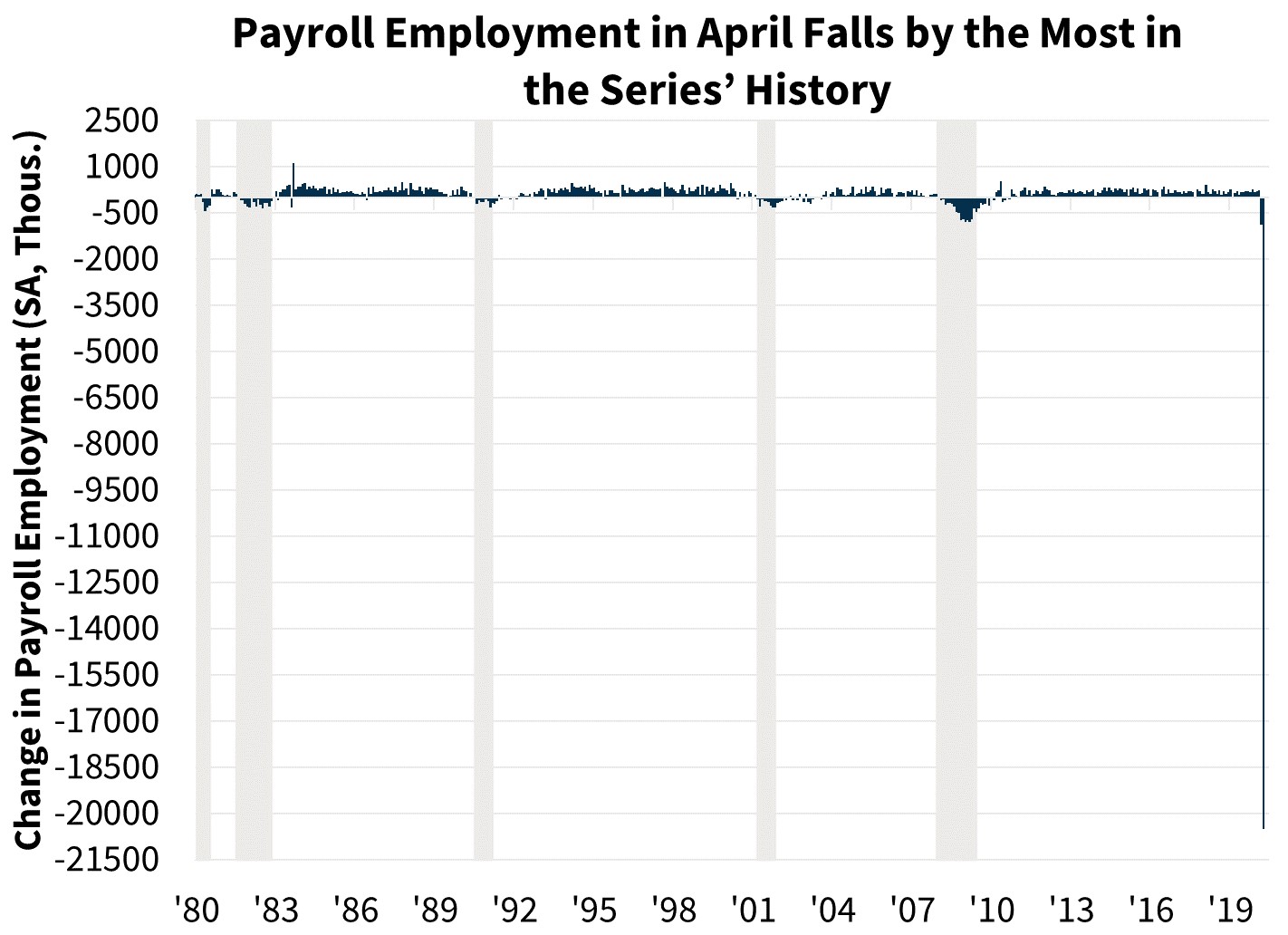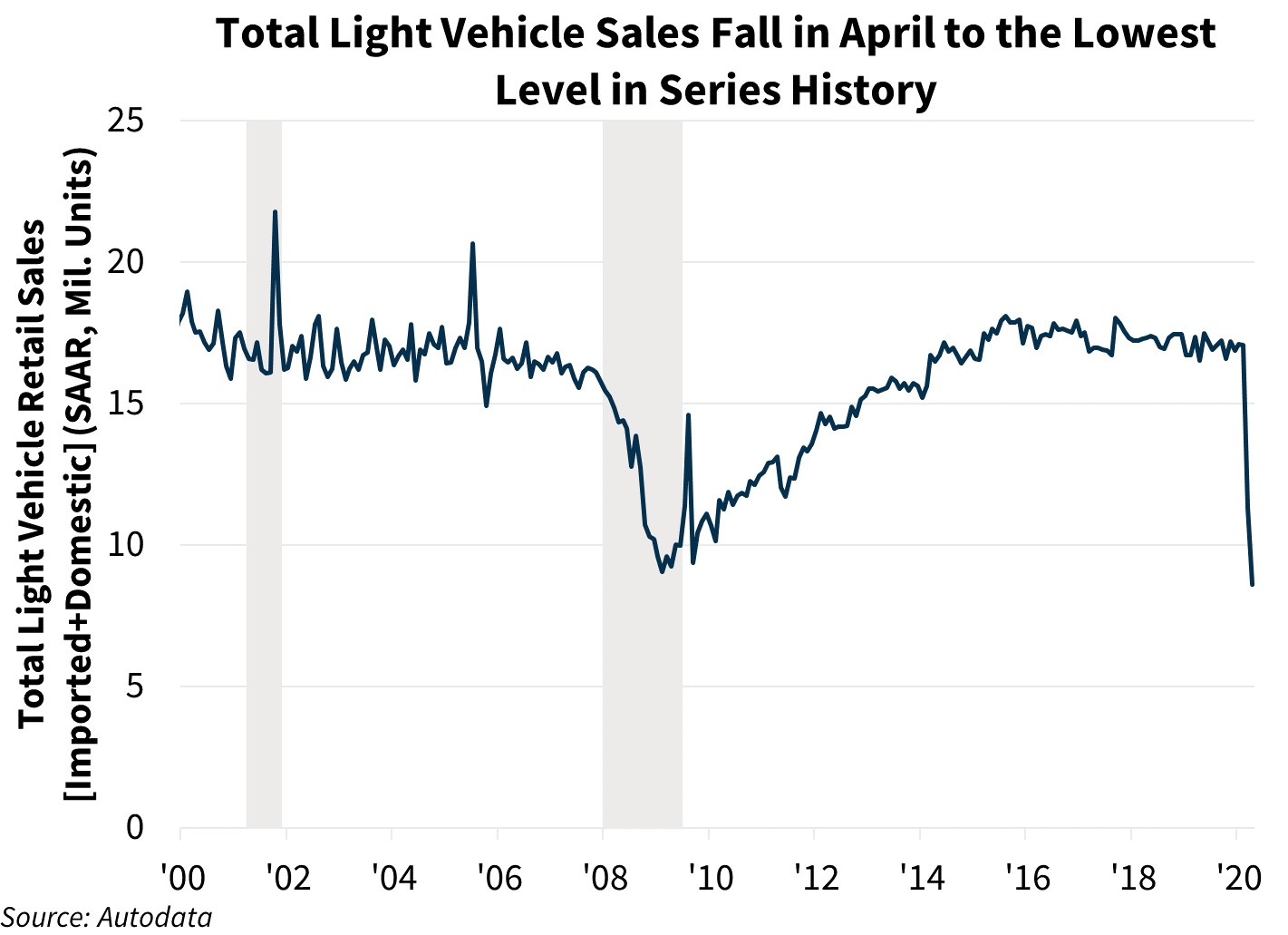Significant Contraction in the Job Market as Coronavirus-Related Shutdowns and Layoffs Continue
Key Takeaways:
- Nonfarm payroll employment fell sharply in April, declining 20.5 million, the largest monthly decline in the history of the series (dating back to 1939). The unemployment rate jumped to 14.7 percent, the highest in the series’ history, and the Bureau of Labor Statistics (BLS) stated that it would have been about five-percentage points higher if they had removed instances of non-sampling error.
- Light vehicle sales posted the second straight month of double-digit declines in April, falling to a seasonally adjusted annualized rate (SAAR) of 8.6 million. According to Autodata, this is the lowest level since the series began in 1980.
- Nonfarm business productivity fell 2.5 percent annualized in Q1 2020, according to preliminary estimates by the BLS, the second decline in the last three quarters, and the largest decline since Q4 2015. Real output decreased by the largest annualized amount in 11 years, while unit labor costs grew by the fastest pace in a year.
- The ISM Nonmanufacturing Index, a gauge of service sector activity, fell to 41.8 in April, the largest monthly decline in series history. The reading fell into contraction territory for the first time since December 2009 and to the lowest level since March 2009. Any reading below 50 indicates contraction.
- Factory orders dropped 10.3 percent in March, falling to the lowest level since November 2016. Nondurable goods orders posted the largest decline since the end of 2008.
- Consumer (non-mortgage) credit outstanding dropped by approximately $12.0 billion in March, according to the Federal Reserve Board, the first decline since December 2015. Revolving credit (largely credit cards) drove the decline, falling $28.2 billion, the largest decline in series history, while nonrevolving credit (largely student and auto loans) increased $16.1 billion.
Forecast Impact
While historic, the sharp contraction in the job market was not unexpected given the surge in unemployment claims during the month of April. Such a sharp decline in payroll employment supports our expectations of significant contractions in both consumer spending and economic growth in the second quarter, highlighted by both the historic drop in April light vehicle sales and the sharp decline in April service sector activity. Most consumers are currently foregoing non-essential purchases, as economic uncertainty continues to climb and confidence erodes, leading to the historic decline in outstanding revolving credit in March. The decline in both March durable and nondurable goods orders, which are forward-looking components of business fixed investment (BFI), suggest a likely contraction of BFI in the second quarter. Furthermore, we believe the drop in productivity and the jump in unit labor costs will likely eat into corporate profits and erode potential investment. Hourly wage workers, who are more prevalent in the service sector, have been hit hardest by the COVID-19 pandemic, while salaried workers appear to have been more insulated in terms of employment. This dynamic may suggest less impact on homebuying demand than some forecasts imply. The supply of housing is likely to feel more stress in the coming months as residential construction employment fell sharply in April.


Details on Key Takeaways and Other Releases
- Nonfarm payroll employment fell sharply by 20.5 million in April, according to the BLS. Payroll employment in March was revised further downward by 169,000 for a total drop of 870,000. The three-month moving average fell to negative 7.0 million. Average hourly earnings increased 4.7 percent over the month and 7.9 percent from a year ago, since the majority of job losses occurred in lower-wage sectors where hourly workers are disproportionally impacted. Among unemployed persons, the number who reported being temporarily laid off (who are officially counted as unemployed) jumped by 16.2 million this month to 18.1 million, and the number of people working part-time but who would prefer full-time employment increased by 5.1 million to 10.9 million. The total labor force fell by 6.4 million, the largest one-month decline in series history. The labor force participation rate fell 2.5 percentage points to 60.2 percent, the lowest level since 1973. Manufacturing employment fell by 1.3 million, while residential construction employment (which includes specialty contractors) declined by 415,000 jobs. Employment in the leisure and hospitality sector fell by 7.7 million, or approximately 47 percent.
- Light vehicle sales fell 24.1 percent in April to a SAAR of 8.6 million, according to Autodata. Car sales and light truck sales (which includes SUVs) dropped 31.4 percent and 21.5 percent, respectively. From a year ago, total light vehicle sales fell 47.9 percent.
- Nonfarm business productivity fell 2.5 percent annualized in Q1 2020, according to preliminary estimates by the BLS. Real output decreased 6.2 percent annualized. Total hours fell 3.8 percent annualized, and unit labor costs jumped to 4.8 percent annualized. On a year-over-year basis, productivity rose by 0.3 percent, a sharp deceleration from the prior quarter’s 1.8 percent pace.
- The Federal Reserve Board Senior Loan Officer Opinion Survey for the three months ending in April showed that banks reported a moderate tightening in lending standards for non-GSE eligible mortgages and Home Equity Lines of Credit (HELOCs). A modest number of banks eased lending standards for government residential mortgages, while standards for GSE-eligible mortgages were relatively unchanged. Banks continued to report strong demand for most residential mortgages, while demand for HELOCs was unchanged. Banks also reported a major tightening of lending standards for commercial real estate loans in the construction and land development categories, while demand for these loans fell sharply.
Economic and Strategic Research Group
May 8, 2020
Opinions, analyses, estimates, forecasts and other views of Fannie Mae's Economic and Strategic Research (ESR) Group included in these materials should not be construed as indicating Fannie Mae's business prospects or expected results, are based on a number of assumptions, and are subject to change without notice. How this information affects Fannie Mae will depend on many factors. Although the ESR group bases its opinions, analyses, estimates, forecasts and other views on information it considers reliable, it does not guarantee that the information provided in these materials is accurate, current or suitable for any particular purpose. Changes in the assumptions or the information underlying these views, including assumptions about the duration and magnitude of shutdowns and social distancing, could produce materially different results. The analyses, opinions, estimates, forecasts and other views published by the ESR group represent the views of that group as of the date indicated and do not necessarily represent the views of Fannie Mae or its management.
